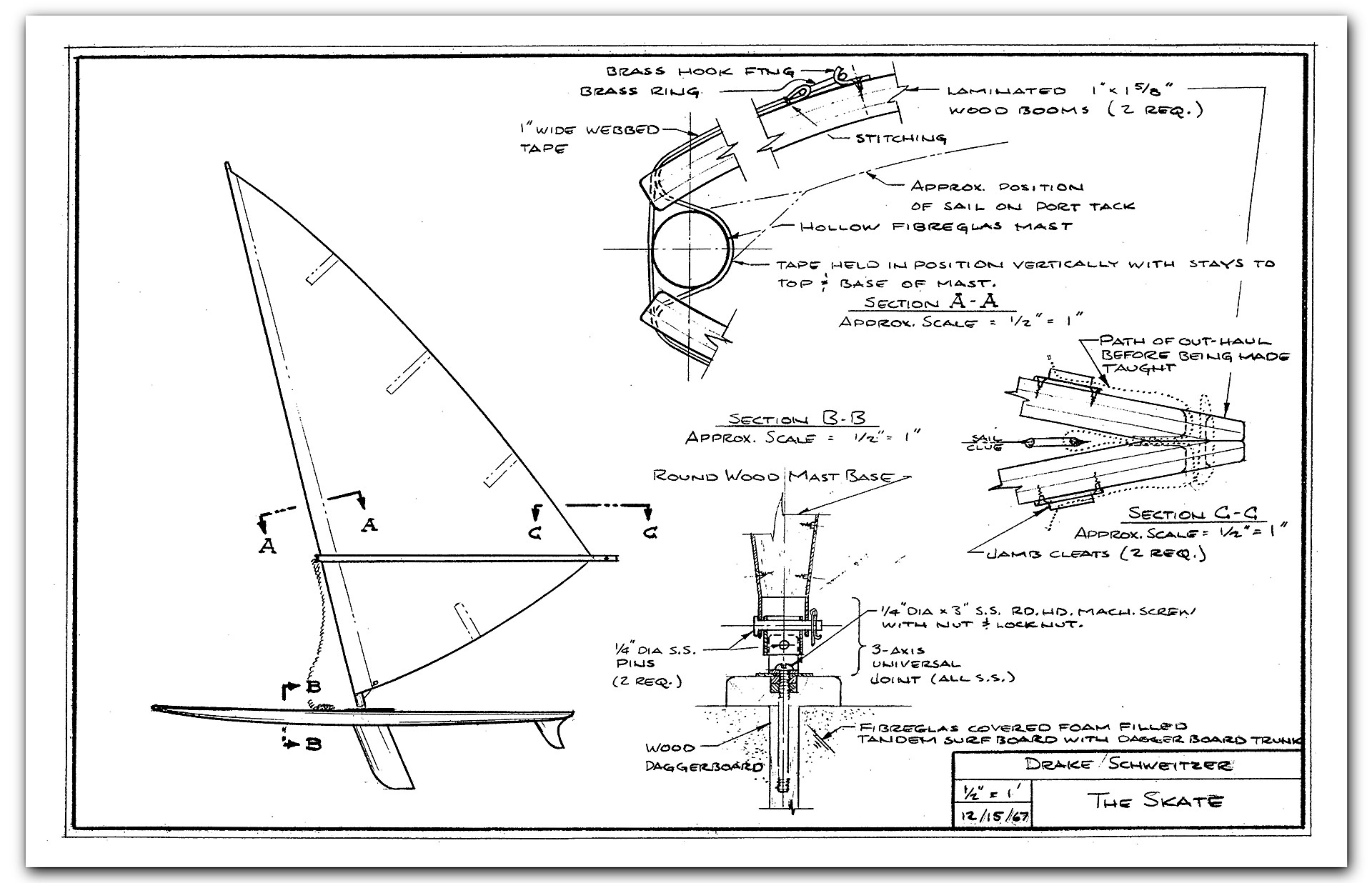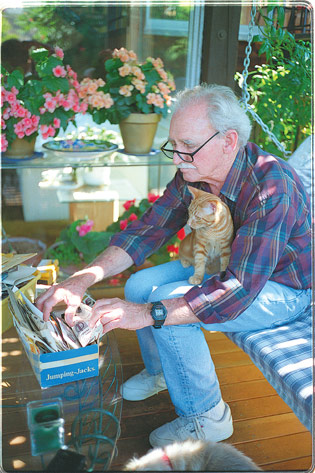
MY FIRST IMPRESSION of Jim Drake, both on the phone and in person, revealed to me that here is a man of unparalleled modesty. The co-inventor of windsurfing is way too busy chasing new ideas than to sit back and bask in the glory of his past. With a constant flow of new ideas Jim Drake is perpetually throwing himself into the frying pan, only to jump back out to the drawing boards.
On the day we first met in L.A., I managed to persuade the 67 year old inventor to pack up his windsurfing gear and drive to Cabrillo Beach. The beach was littered with gear and a few sailors were already enjoying the afterglow of a good day’s sailing. Drake, the creator of their passion, waltzed by them in perfect obscurity and not one soul, including myself realized that something magical was about to happen.
Now, no one on that beach would have known that on May 23, 1967, the grey haired gentleman walking toward the water took his family and a new contraption he called the “Skate” (see pictures here) to nearby Marina del Ray and became the first person to sail a windsurfer. No one could have known that this man they had watched rigging was about to make history.
Advertisement
It’s an overlooked fact-Every time that Jim Drake goes windsurfing, he re-writes the history books. The reason is simple. No one has been windsurfing longer than Jim Drake.
REMINISCING WITH FRISCO THE CAT: Searching for aged photos and illustrations in his Jumping Jacks box. (bellow) Drawing by Jim Drake on Peter Chilvers’ and Newman Darby’s wind driven concepts that came before the Windsurfer.
AMERICAN WINDSURFER: There has been some controversy about whether you were the inventor of the windsurfer.
JIM DRAKE: Yes.
AW: The original windsurfer.
JD: There is no controversy in Europe.
AW: There have been antiquated pictures of people on board-like crafts with square rigs planted on them, but can we say you invented the universal joint?
JD: Well that is not exactly right.
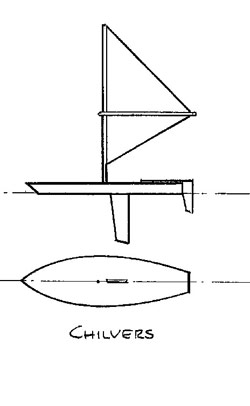
AW: Pray, tell.
JD: I probably can be credited with invention. But I think I was probably no better than third. The other two being, ostensibly, one guy in the midwest named Newman Darby and then a young English gentlemen, a boy at that time, Peter Chilvers, who had a very plausible story about having constructed a sail tacked to a pole with straight booms on both sides and attaching it to a hollow cored door which served as a raft while he was on vacation someplace in Great Britain. This would have been sometime around the early sixties. Newman Darby, as we all know, came along in ‘65 or ‘66 or thereabouts, and he had a universal joint, a square rigged, well a diamond rigged, sail that he advertised for sale in Popular Mechanics and several other places.
Neither one of those designs succeeded, but both had a universal joint. So it can’t be said that I was the first to invent the universal joint. Although, I had no knowledge of these two earlier efforts at the time. But because of those earlier efforts I consider myself not the inventor, but the re-inventor.
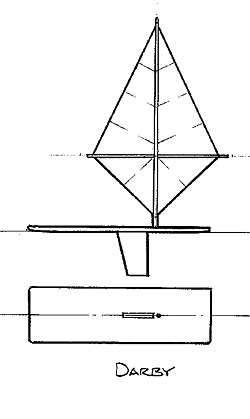
My contribution was to make the thing actually efficient and workable. Neither Newman nor Peter were technically oriented people and they didn’t appreciate how important streamlining of the hull or board was, and they certainly didn’t appreciate the efficiency or the ways about getting efficient sail design. What they did have in mind has turned out to be the main pleasurable ingredient about windsurfing–and that’s standing up and holding on with your hands and controlling everything with your hands. That is very much more the natural position than the traditional sailing position, which is either sitting in the middle of the boat or out on the rail or on a trapeze and having levers and all kinds of mechanical garbage laying around. This isn’t to say that it’s a bad thing, a lot of people really like it. But it’s the simplicity of standing up so you can adjust your weight and move quickly as well as actively participate in transmitting the sails’ forces to the board… in other words, being the necessary link between the sail and the board is what is the great contribution of windsurfing. It happened unfortunately for Peter and Newman, that their concepts of how to go about this were hopelessly inefficient. So much of the fun you and I get out of windsurfing, going pretty fast and maneuvering and having a light, light aircraft feel about it—all that was lost on them. They had no way of being able to experience this, so they just quit as a result.
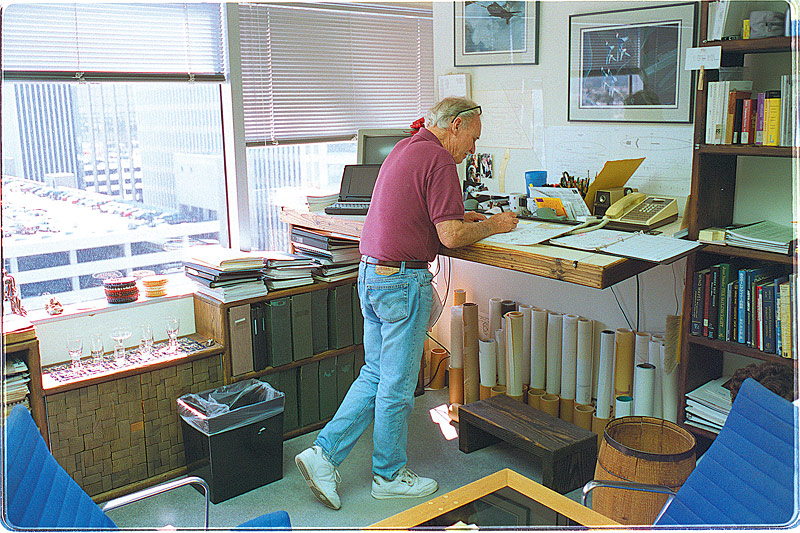
HARD AT WORK AND PLAY: Office at Logicon-RDA, a private think tank funded by the Defense Department. (below) Working on a new toy.
AW: Before I ask you how you came about the idea—you had no knowledge of what was going on with these people?
JD: No, but had I seen Newman’s article, it might have helped me get to the universal joint more quickly. Let me tell you the thought process I went through. It was a long process, it wasn’t any great overnight inspiration!
It all began in 1962. The origin of this was in a conversation I had with Fred Payne. He unfortunately died several years ago. He was my boss at North American (Rockwell) for the period which I was in the advanced design group and he went on to a big position in the Pentagon… in the ’62,’64 era.
Advertisement
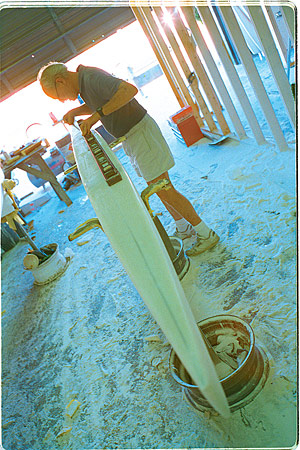
We always remained very close friends. In fact, we were probably each others’ closest friend. He was also an aeronautical engineer so we had a great deal in common. We were also at that time waterskiing, snowskiing and doing quite a few things together of that sort. He went off to the Pentagon but from time to time came back to Southern California to visit people, me included. One night, here in this house, we got to discussing waterskiing and sailboats. Since he had just rented a house on the Potomac River, he said. “You know we ought to experiment with something that would go on the Potomac that is wind powered–a little bit like a wind powered waterski.” Well, we both knew hydrodynamics enough to know that you couldn’t possibly get enough power out of a sail on the Potomac, which has almost no wind.
We concluded it might be interesting to see how it would be to drive a surfboard on the Potomac and maybe we should, in some future month, build something and try it. We never did. What we conceived that night was related more to aeronautics than it was to hydrodynamics because we said, “Maybe the right way to power it is with a kite, a big hand held, hand maneuvering kite.” That certainly will work and this way you can get a good high aspect ratio and powerful machine—a little bit like the young man’s parafoil that he uses up at the Gorge. In fact, identical to that idea, but without a waterski. The idea at the time was with a hull of some sort, probably a surfboard. The night went on and on and on. As usual, brandy corrupts one’s intelligence and we thought we had an absolutely splendid idea. By the end of the evening, light was dawning and Fred had to go catch an airplane, so he went off and I went to bed.
I thought about that conversation later but I didn’t do any design work. I did a few calculations and I persuaded myself maybe it wouldn’t work that well because you would have to give up a lot of the lifting power of the kite just to keep the kite up. The technology then didn’t have the para-foil, which is very light weight and therefore much more efficient. So I abandoned that as an idea, but the concept of standing on a board and holding something sounded like a great idea to me.
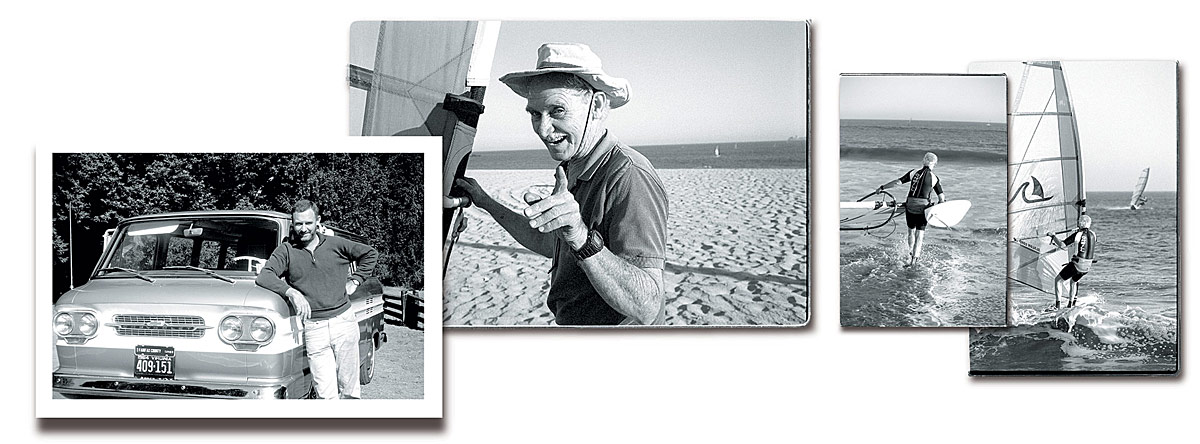
DRAKE IN THE SIXTIES and today, making history, every windsurfing day at Cabrillo beach. (bellow) Jim Drake’s historic 8mm footage of the first windsurfing outing at Marina Del Rey on May 3, 1967.
Many things went through my brain over many years. Idly, I would bring it out and turn it over in my mind to see if there wasn’t a way to do it. However, I always came back to the sailboat’s need for structural integrity of the mast and sail. All that didn’t sound right to me. It sounded like trouble. The wires or ropes that are used, if you fall on them, will cut you and that just didn’t seem like the right answer. In any event, there were already quite a few so called “sailboards” on the market; Sunfish, Sailfish, and others.
In fact there was a big crop of them available for a period of time in the mid sixties, all hoping to capitalize on the idea of a simple device. I don’t know why they didn’t succeed, except they’re just all copies of the Sailfish pretty much and probably copied their heavy weight and poor aerodynamics as well.
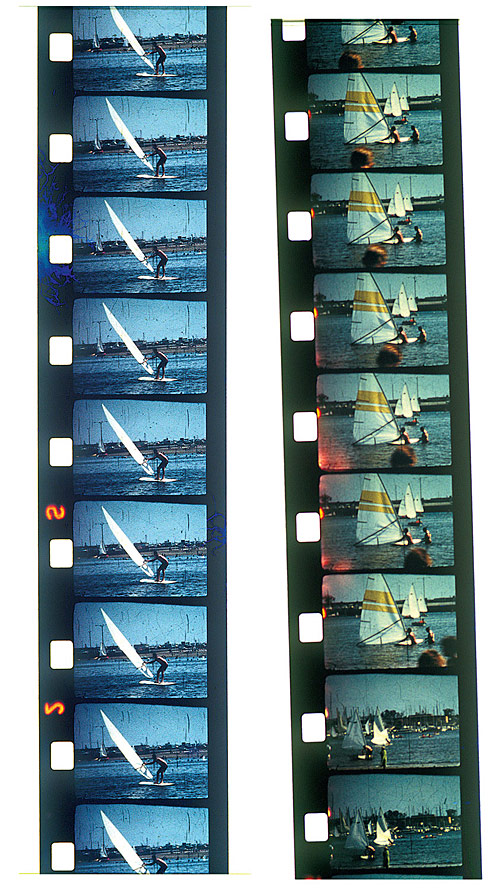
Also during this time the Schweitzers and the Drakes were close families together. Diane [Schweitzer] was pregnant with her first child Tara when Wendy [Jim’s wife] first met her and they became friends. Eventually the two families became close friends. Matt [Schweitzer] came along, Holly came along, my Matt came along, then Andy came along and all the rest of them. We frequently went to Baja and waterskied in Estero Bay, which I understand is now almost totally destroyed by tourists. We camped in the mountains and deserts of Southern California and were always going on trips of one kind or another together. So it wasn’t unusual that we would spend evenings at each other’s house. One such evening, in 1966, while I was on leave from North American and working in the Pentagon on a study on ballistic missiles, new ballistic missiles to save democracy…
AW: [chuckles]
JD: I left my family here and was traveling back and forth [to Washington]. During one of these visits I idly mentioned to Hoyle that it always seemed like a good idea to have a surfboard-like thing and a sail-like thing, and to stand on it and to have fun. Hoyle just thought that was a brilliant idea. He had no idea what I was talking about, nor did I, really, at that point. He said: “Oh that’s super! Let’s do something about it!” I suppose brandy was having its effect there too. Hoyle said, “Let’s go and build a board.” Well, I wasn’t prepared to build a board because I didn’t have the whole concept in mind particularly. But I said, “Ok, I know some of the things that are required of the board so it wouldn’t hurt to build it and do something about it.” I knew, for example, you needed a centerboard to counteract the forces of the sail. I didn’t know about fins or rudders, that was still fuzzy on my mind. But then, in January or thereabouts, of ‘67, we built a board. I was still in the process of thinking about the centerboard and at this particular time I was still working on this technical committee back East. I was doing a lot of traveling to Southern California, mostly to meet with technical people out at the Norton Air force Base, which was at that time was the Space and Missiles Command of the Air Force.
So I would be driving from here to there, which was about an hour and half trip then. Once the board was built I was a little bit on the embarrassed side and I felt like “Ok, now I better get with it and figure out how to make this thing work.” So I went through the process of deciding how the sail should be mounted and how to control the board. For all these things, the devices are designed primarily by the control system not by the power source. Usually, you have plenty of power but you need a control system. Well how do you steer a board like this? I went through in my mind all the ways I could think of. There is the traditional rudder, and the action between rudder and a center board, but there are other ways. Ways of using a sail only. Traditional sailing vessels use only sails.
AW: In the old days?
JD: Yes, in the old days. In the 1600’s and so forth. They had multiple masts and you would trim the forward sails to one particular angle of attack, the rear sails to another and you could create a turning movement in either direction, depending on how you adjusted the angle of attack of each of the two. That’s the way the old boats were all designed and controlled. The rudders that they had were used for trim if anything, not for the actual steering.
Well, this was another way of controlling the board, but you would need two masts. Unless, and now here was the breakthrough if ever there was one during those drives between here and San Bernadino…
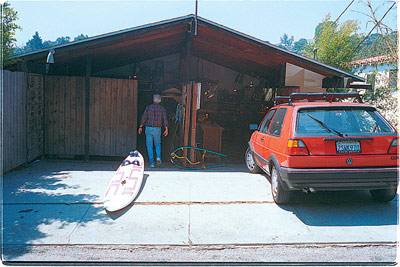
AW: So a light came up and “Eureka!”?
JD: Well lights never go “click!” in that sense. It’s only in retrospect you imagine “click!”. [both laugh] These ideas ooze out and there they are before you know it and they seem like they’ve always been there. It’s not “click” it’s “Ohh…”, “Oh yeah…”, “Oh sure!”. Sometimes they’re good ideas, bur most times they are bad ideas as subsequent tests usually reveal. All these beautiful, great, glorious thoughts that I and other people have usually fall down pretty badly. In fact, I don’t think more than one out of ten of my ideas have been good in the sense that they are good and practical. The rest are just terrible.
Anyhow, this, as we all know now, was a very good idea. The choice between rudders or moving the sail or the sail’s center of pressure, that was an unexplored area. So I said, “Well I’ll think about that. Now how do I move the sail?” Only two ways. You can either rotate the sail or you can move it linearly. Since moving things linearly is usually mechanically more complicated, I said, “I’ll explore the rotation business.”
Even there, there are two possible ways of doing the rotation. One is to do the rotation around a universal joint mounted on the deck so that you can move the sail both fore and aft and side to side, as well as trim—you always have to trim. Or, create a longitudinal degree of freedom, that is, only having it rotate fore and aft. That will move the center of pressure in the right direction depending on what you want to do.
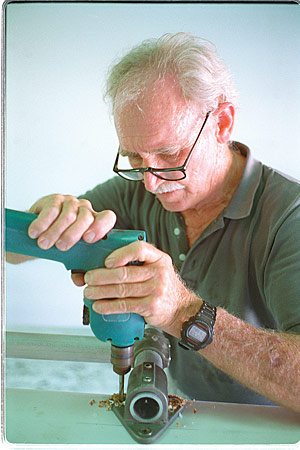
In the long run, I built copies of both to try them out. But back to the story… Now, we know we’re going to move the sail rather than move a rudder to control it and we know we’re standing because that was the original idea and that’s what was in the back of my mind a lot. Now, how do we get to hold a sail? To be able to actually move it?
The wishbone boom had already been invented, well, I’m not sure invented, but at least demonstrated on the East coast many years before in ocean racing circles for booms on a mizzen mast. They were designed to allow an efficient profile of the sail over the entire length of the mast. It was not successful in ocean racing however because it was too flexible and had the wrong response to high winds. So it never became good for that. But lo and behold, it became just the right ticket for windsurfing to hang onto the sail. Everything had really fallen into place now. I knew I could stand, hold on to the sail and adjust the center of pressure. Gee whiz! I was not exactly ecstatic, but after several days of having thought about it, I couldn’t see anything terribly wrong with it. The next step was to build it and see if it would actually work the way we predicted.
I had no way of buying any of this [material as it’s not available in the open market, so I had to build it in my garage—which I did. The wishbone booms were the toughest. They were made out of pine lathe, used in building trades for door stops and furrings. I laminated three or more, I think it was three layers, together with glue in between which I set on a form until the glue dried. I attached them together at the front with webbing and a series of what I’d hoped to be powerful cinchers to be able to get the boom and the mast all tied together. While I succeeded in tying everything together, it was a little bit on the loose and wobbly side. However, it did set a sail in between it. For reasons I can’t quite remember, I selected a sailmaker named Bob Broussard. I left the booms and mast with him, the mast had been provided by Hoyle, and he built a sail that stretched along the mast that had the proper belly and curves to it. Then one day in the middle of May 1967, Wendy and my daughter Stephanie, Wendy was pregnant with my son Alex, which is how she can remember it exactly, brought along an 8mm camera and off we went to Marina del Rey. It’s there today, but there is no plaque for it though, unfortunately.
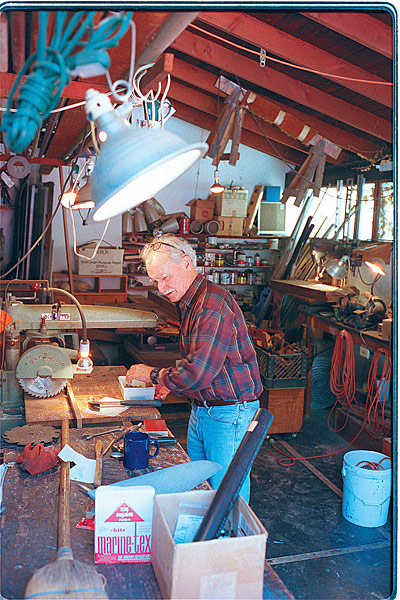
AW: [laughs] Maybe we should plant one.
JD: Not a bad idea, it’s kind of a crummy beach though.
AW: [laughs]
JD: Anyhow, we ran into Bob Broussard riding his bike and dragged him along with us. We assembled it on shore. The first thing I did was walk out and stand on the board to see if it was stable enough. I brought along both versions of the universal joint arrangement. The first one I tried was the one in which the centerboard was rigidly attached to the mast and allowed only longitudinal movement of the sail. That didn’t work out too well initially because the water was so shallow. I couldn’t actually get on the board and get it out to any position that I wanted to. So I abandoned it, although that arrangement will work, I’m sure. So I put the universal joint version on it and I got on the board…and uh…this is a example of how inventors always forget something…
In this case, since I always imagined myself standing on the board holding onto the sail, I had never considered how to get the sail out of the water.
AW: [laughs]
JD: It never occurred to me that that was going to be a problem. I just didn’t think about it. Anybody knows to try to pull the damn sail out of the water without an uphaul is impossible. Unless you know how to waterstart. Of course, I didn’t at the time. So I roped in Bob Broussard to wade out and lift up the sail and give it to me. I could hang on to it but I wouldn’t go very far before I fell. Then we would repeat the process.
I was very, very discouraged with all that because while I could see it kind of going, this notion of getting the sail up was just defeating me. It was also very tiring and I wasn’t altogether sure that everything was working very well. One other reason was that I forgot the skeg at home! [laughs] Not too bright. Trying to control the board without the skeg was very tough, as you can imagine.
That was a very discouraging first day. Very, very discouraging. Driving home, I said to myself, “How am I going to get that sail up?” The light goes on. Stand on the board and pull up the sail with a rope! So I incorporated a rope and maybe two weeks later went back to Marina del Rey, put on the skeg, put on the, what at that time I called a lanyard. It’s now called an uphaul.
AW: A lanyard?
JD: A lanyard is a short length of rope used to pull. Often lanyards are used to pull the firing mechanism of a canon. That’s where it mostly comes from, it’s not a sailing term, I don’t think.
So, two weeks later, I put everything back together and went down to Marina del Rey. It was still very, very difficult, but I could at least get the sail up and control the board and begin the process of teaching myself how to sail. I knew mechanically how to maneuver, that is, put the sail back, the board goes up, put the sail forward the board goes off the wind. In my mind, I imagined, since it was a universal, that I could walk around the base of the mast for jibing and I could walk around the front of the mast for tacking. That was all in theory in my mind. But theory is one thing, practice is very, very different.
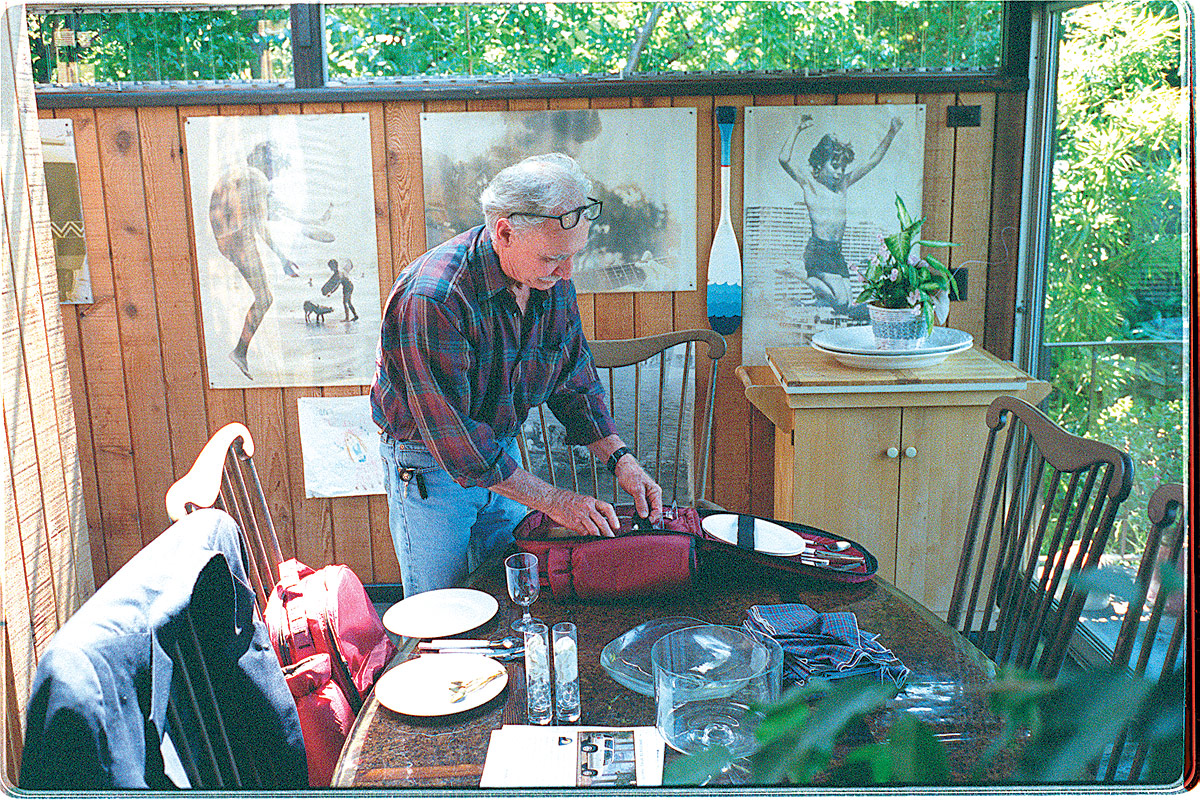
AW: So you had to teach yourself how to windsurf?
JD: Yeah! Basically. There wasn’t anyone else to teach me.
AW: You were the first!
JD: That’s right. A few weeks later, well…I should say just after the first, what I consider, disastrous try, Hoyle organized a party for the celebration of what at that time we called the “Skate.”
AW: The Skate?
JD: The Skate. We thought that would be a great name for it. Trouble was, another small boat was already named the Skate so that took care of that. It went from that to being the “Baja Board” and then finally the “Windsurfer.”
AW: How did it come to be named the Windsurfer?
JD: That was a name coined by a young P.R. man from Seattle whose name is Bert Salisbury. Late in ‘67 he saw the board through Hoyle. He stopped his car, went out and found out what this was and said: “Gee I have the perfect name for it! The WINDSURFER!” Cool. So that’s the way it was. Maybe not ‘67, maybe ‘68 for the name.
Anyway, we displayed this board at the party that Hoyle organized and he considered we all go to the beach and try it. I said, “Not a chance, there isn’t anyway that we can control this board. I’ve no idea how to make it work so we’re not going to do it. But what we will do is set it up.” So we did. We set it up using the single degree of freedom mast configuration, because that would at least keep the sail up, otherwise it would be flat on the ground.
And that’s how it began. Never looked back from there.
AW: Did you ever imagine the success your invention was to achieve?
JD: [chuckle] Since I have a good imagination, of course I imagined it could. But I was also realistic enough to know that it’s hard to predict the outcome of these things. A lot of good ideas for one reason or another, sometimes good sometimes not, don’t ever succeed.
AW: So you were quite discouraged?
JD: Oh yes, at the outset. But then Hoyle’s natural enthusiasm for it made me feel a lot better about it. Hoyle is a natural athlete. He is just as quick as a cat. At least he was then, and so he taught himself much more quickly than I. Though I was athletic, I’m not that good. Not anywhere as skilled as he is or was. So his natural enthusiasm carried [us] along and from the very start he was much more interested in promoting it as a business. Certainly more active than I was.
AW: How did he come to buy you out?
JD: Oh dear, very painful.
AW: Painful huh?
JD: I’ll give you the short version. In 1969, Hoyle’s business came under pressure and collapsed, leaving Hoyle with very little source of income. At the time, he was considering moving to Newport Beach, the whole family and all. He was very active at that time, trying to promote Windsurfing International. When we named it that corporation, we put my house, here, as the location of the corporation. Shortly after he moved to Newport Beach, his firm collapsed. At about that same time I accepted another position in the Pentagon and left for two years on a leave of absence from the Rand Corporation, where the paper that you discovered was prepared.
Almost overnight, after we got ourselves settled in Washington, Hoyle called me wanting to get some arrangement for a buyout of my half of the patent. I told him, in writing and verbally that I wasn’t interested in selling anything, particularly since we didn’t know what it was worth. It was hard to put any price on it– why don’t we just let it go the way it is and see how much it’s worth eventually? He was pressuring me quite a bit, and I said, “We’re in this together, aren’t we?” Well, it turned out that no, we weren’t really in this together. It’s true, we were joint owners of the patent, but that was all. Hoyle had incorporated Windsurfing International all on his own. At the time I didn’t realize that one could do that. I thought that if you owned the patent, then you’re also joined together. It was a big shock to me when he said, “You can, of course, if you want to, be a salesman for Windsurfing International.” That took me aback a little bit.
AW: What do you mean?
JD: Well, we jointly owned the patent, but he formed Windsurfing International as a separate company, not including me.
AW: Windsurfing International is the promotional side of…
JD: It is the promotional side, that’s right, that built the boards and commissioned the sails and set up dealerships and sponsored races and all of that, and that was the firm up until the expiration of the patent in 1988. Well, I was really annoyed at him for that, but friends are friends, and you’re supposed to overlook a few things like that when they happen. Obviously, if he did it for a good reason, then okay. And that was what it finally turned out–the reason he was pressuring me to sell my half of the patent. But I said, “No, I don’t want to do that. I’d rather be part of the company than sell you a part of the patent.” No dice on that. So two years went by, and in 1972 he got back on the subject and pleaded with me to sell my half of the patent. He had several proposals with very elaborate buyouts, royalty, this and that. That just made me… I wasn’t very happy about that at all. But, here is a friend wanting to buy this thing from me…
AW: But you weren’t actively involved?
JD: No. Mostly because I was a little bit annoyed that he tipped me out of the firm. So that kind of rankled, I wasn’t really active, either windsurfing or as a part of Windsurfing International.
AW: This was in 1972?
JD: Yes, 1972. At that time I was back in Southern California. I remember thinking to myself, “Good grief, if he really wants it so badly, okay, I’ll sell it to him.” Here’s a friend, he’s had all this other little unpleasantness, what am I doing with it anyhow? If he says it’s an encumbrance to his promoting it, why not do him a favor, and sell it. So I did.
AW: Are you willing to say how much you sold it for?
JD: Thirty-six thousand dollars.
AW: WOW! But that was a lot of money back then right?
JD: Well, it was all right. But there’s a happy ending to this story, you know. Hoyle, much to my annoyance, later on made a great success out of it. Worldwide. Which produced a degree of fame for me that I probably never would have had on my own. Probably not. So, as pissed off as I was at him, even at the time, and in later years, it was not wholly without recompence to me.
AW: Elaborate on that a little more.
JD: Well, he made windsurfing famous and made me famous along with it. So, it’s hard to say I’ve gotten a lot of money out of windsurfing, in fact the answer is thirty-six thousand dollars. The annoying thing, had I known at the time, was that he had already signed an agreement with Ten Carte in Holland when he was negotiating with me for the sale of the patent and he didn’t inform me of that. That was the basis of the suit that Bic instituted on my behalf in the early ‘80s. That was a very unpleasant time too. Very unpleasant.
So, Hoyle made both money and a name for himself. Hoyle, as I said in other instances, many times, has a number of good virtues. He is a tireless promoter of the sport and as I said earlier, he is quite an admirable athlete, skilled. Good father to his family. He and Diane had a loyal, and to my understanding, very close working relationship, which would be envied by a lot of people, a relationship of that kind. A husband/wife team in business isn’t always a success. Most often it’s not. In this case it was a great success. So, there’s many good things about Hoyle.
[The sport] could have easily stopped right there in Jamaica Bay if Hoyle hadn’t seen the commercial possibilities and taken action. For my part, I had an entirely separate and successful career and felt little motivation once the concept proved both sound and fun. I felt then and feel now a lot like the father of a talented child that I treated with benign neglect. Mother Hoyle was the one to feed, clothe, and protect. Some actions he took were beneficial, others were very damaging and uselessly hostile. So, like warring parents, we became estranged and remain so.
AW: The sport has really changed hasn’t it?
JD: Yes it has. Oh yes.
AW: How do you feel about that?
JD: I have an optimistic view about the sport. It certainly, at least, has hit a plateau, and I think the reason it has reached this plateau is because there are some natural barriers to participating in the sport. Some are brought on by the media and some are brought on by nature.
The one that’s brought on by the media is the picture of the sport as being this athletic circus trick of jumping waves and whirling around this great wide ocean. Well, that’s simply not what the sport is. Just not at all. It has much more broad application and pleasures to it. Because people who are athletically inclined but not as superbly coordinated as Robby [Naish] can enjoy the sport in many regards without having to ever get airborne. I think that’s a media created problem for the sport. But it’s hard not to be more energized first with spectacular photos though than it is for calm lakes and all.
I think that the natural barrier that has come about, which perhaps technically can be breached, is the wind barrier, on the low side. If the sport were able to create a board and sail which allows pleasurable fun for the not very good, in 8 – 10 knots of wind, two things would happen. First, the number of sailing spots would go up by a factor of ten. And second, the number of people who can do this, or the number of people who can now see themselves as actually participating in the sport would go up by ten thousand. So for notch reduction, and the lower limit of the wind speed for the board, you’ll create several factors, wind spots and people. That’s just natural.
But hey, if I were so smart, I’d be as rich as Hoyle! [Both Laugh]


